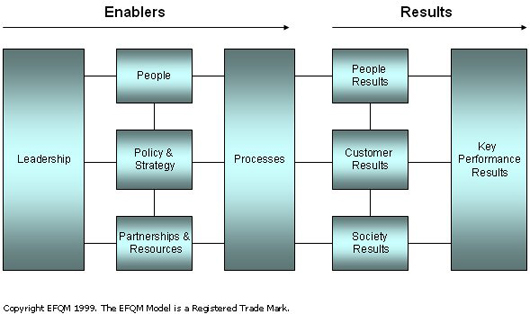

| Call us on 01892 458156 or 07970 064277 | Email us on bis@brianmead.com |
|
The EFQM Excellence Model
Many users of the Excellence Model will have started out on the quality journey by implementing quality management systems such as that defined by ISO 9001, however this alone has not always enabled a business to excel, or reach the top of its particular market or sector. Using the Excellence Model however, undoubtedly has..... Past studies carried out into the financial impacts of using the Excellence Model have concluded that financial performance does actually improve when Business Excellence concepts are implemented effectively. The EFQM (European Foundation for Quality Management),
Excellence Model is a framework that can be used by any business
or organisation, whether private, public or voluntary sector, as
a means continuously improving performance. It encourages user organisations
to look at all aspects of their operations, so offering a more holistic
approach covering a wide range of issues such as leadership, people,
partnerships etc., as well as of course customer focus. Typical
benefits are:
If you want to enquire about using the Excellence Model in your organisation do call or email, otherwise carry on here for a little more background information..
The Excellence Model - A Brief Overview
The Excellence Model
Self Assessment Use of The Model is based on internal Self Assessment, and so does not rely on external auditors. This does therefore require the user organisation to be totally committed from top to bottom, as the regular impetus posed by an imminent visit from an external auditor (such as with ISO9000), does not apply. Assessments are made against a range of sub criteria that comprise each of the nine elements. These are basically statements pertaining to specific aspects of running a business, but can be effectively be regarded as questions against which a score is given. Each of the nine elements (criterion parts), of the Model is given a weighting, and this contributes to the overall score. For the system to work it is necessary for an organisation to implement a range of business measures and is therefore collecting results pertaining to aspects of each of the nine criteria. A scoring system, known by the acronym RADAR (see column on left), has been developed for use with the Model, but it is quite possible to employ a simpler method at first until experience has been gained.
A Flexible Methodology It is possible to start using the Model by adopting a relatively simple approach, for example by measuring against just two or three key aspects of each criterion, or concentrate say on just one element initially. Improvements will be evidenced by gradually improving scores, hence continuous improvement. The actions from an assessment session should be themselves reviewed in a timely fashion to maintain momentum, but the interval between sessions is not prescribed. There is also no rule about who should be involved in a specific self assessment exercise, although it would be desirable to involve most key staff at some stage.
Private, Public or Voluntary... The Excellence Model is being used with equal success in both private and public sectors. It is also of value in the voluntary sector as it is arguably just as important that finite resources are put to best use, so satisfying the needs of stakeholders or trustees. The Excellence Model is promoted in the UK by the British Quality Foundation.
If you wish to enquire about using the Excellence Model in your organisation do call or email. |
|
|||||||||||||||||
|
||||||||||||||||||
|
Top | Home Copyright © Brian Mead 2014. All rights reserved. |


